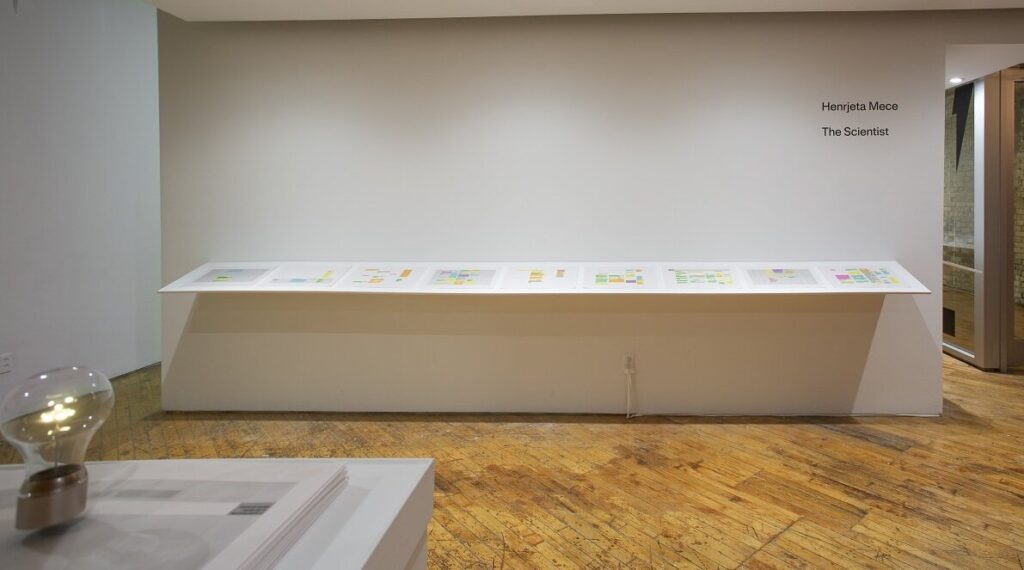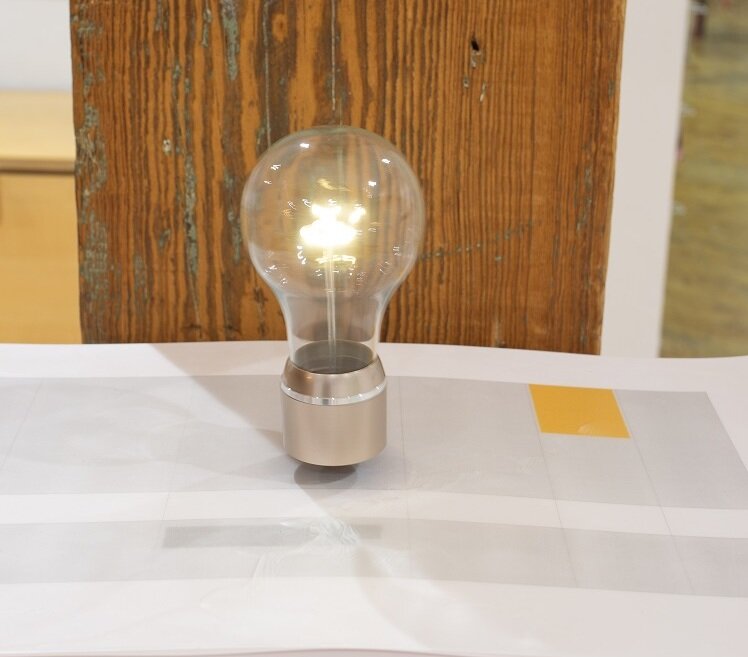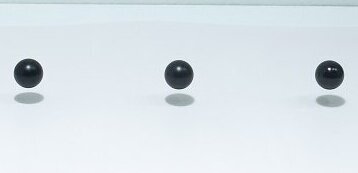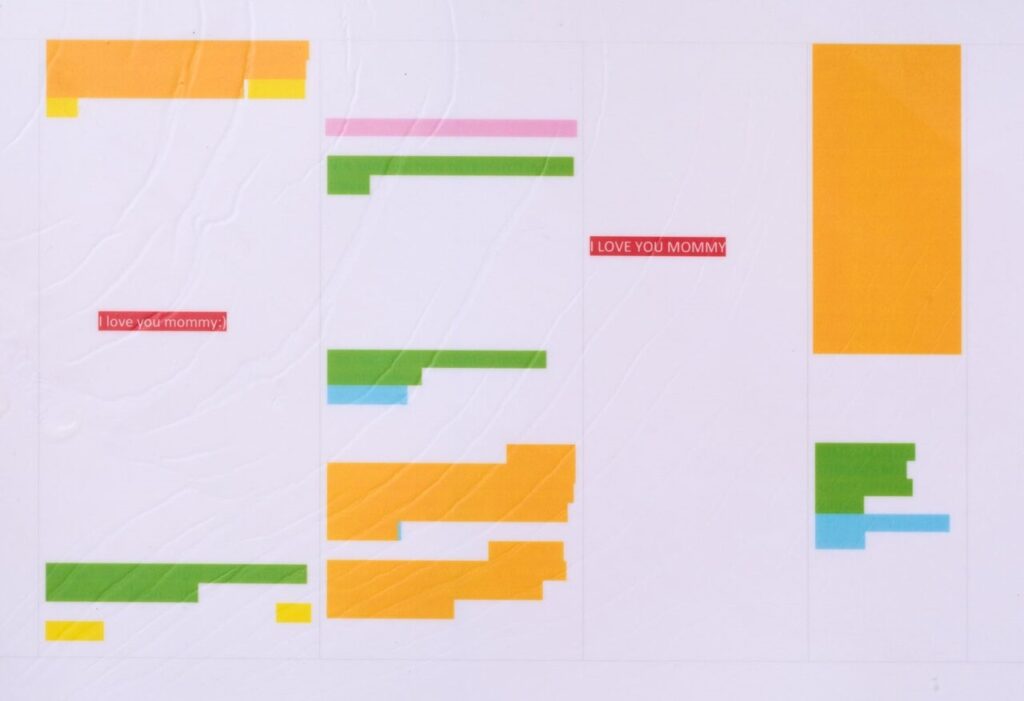Henrjeta Mece’s work is laid out along shelves that span YYZ’s window and turn the corner into the central gallery. It comprises a set of works on paper that are covered in wax. From afar they resemble a series of text that you are invited to read, but up close you are confronted with blocks of colour with the occasional text, which spell out sentences such as ‘I love you mommy :)’. What to make of this?
Installation view of Henrjeta Mece, The Scientist at YYZ
Since C.P. Snow famously spelled out what he saw as a chasm between two cultures, namely the literary and scientific worlds, we recognize how art and science, more generally, operate in quite different spheres, and their respective practitioners barely understand one another. Indeed, in broad terms, science is seen as a rational pursuit. Its aim is to construct theories with their concomitant concepts, think up hypotheses that follow from each theory and then carefully test them, and finally adjust the theory accordingly. It is an objective discipline that seeks truth. By contrast, art traditionally is seen as having none of this methodological structure. The production of art is an intuitive process that has no measurable parameters – leading to what we call artistic freedom. It does not seek truth, but beauty instead.
Henrjeta Mece, Installation view with artworks, each mixed media on paper, covered with wax
But, as Mece recognizes, this clearcut dichotomy between art and science has become quaint and inaccurate – almost an anachronism. Her own experience has taught her this. Encouraged since childhood to make art Mece has also been pulled towards the sciences. After doing two degrees in art, she found herself pursuing doctoral research on the role of artists’ residences on entry into an art career after the education process. She is a trained artist who has become a social scientist teaching at OISE, University of Toronto. She is, therefore, comfortable in both worlds. And one commonality she appreciates between art and science is the research process.
Henrjeta Mece, Light bulb, wireless, floating above paper using a magnet
The emphasis on research, Mece suspects, is a symptom of the academization of art, again something she has experienced firsthand. Increasingly a career in art is premised on obtaining the right credentials. For instance, a couple of decades ago doing a PhD in art was a rarity. Today there are many PhD programs in the visual arts. Credentials provide respectability to the subject, whose worth is otherwise difficult to explain and which doesn’t really fit in academia at all. Such qualifications are premised on research. And now even undergraduates in the visual arts are expected to do research. In this way art has become more akin to science.
Henrjeta Mece, Painted balls floating above paper supported by magnets
What constitutes scientific research is clear enough. Again, it has a defined methodology that involves learning about current theories and evaluating them. But what does artistic research involve exactly? Art is not governed by any theoretical frameworks. That said, there has been an attempt in academia to conceptualize art nevertheless, encouraging students to write theses about their working processes. But what is clear is these processes are not objective in nature. There is no pretense that artists are uncovering the truth. Rather they follow their intuitions and aim to communicate something or other to the viewers. Ironically, there is little room in such research to aim for beauty, so to speak. That goal is outside of conceptual analysis that research demands.
I raise these issues because they are top of mind for Mece. Importantly she has come to believe that science has overestimated its objectivity. While scientists often imagine that their research programs are dispassionately revealing the truth, e.g., about how diseases spread, in fact their methodology has a subjective element to it. Personal choices and interests ultimately inform what and how research is done – something that is recognized in artistic practice. And it is precisely this that Mece’s exhibition comments on. While doing her doctoral research Mece found herself being interrupted by her young children. And their interruptions, she came to realize, actually affected her work. Thus it dawned on her that one’s professional life cannot be insulated from one’s personal life. They inevitably bleed into one another. The children’s comments that pepper her works are emblematic of these influences.
Henrjeta Mece, I love you mommy, mixed media on paper, covered with wax
What intrigues me in particular is the question of the role of the formal qualities in her work on display. These she largely sees as taking care of themselves, in the sense that the distribution of the blocks was predetermined by the arrangement of data for her research. The colours, she told me, were intuitively chosen.
Henrjeta Mece, Installation view with artworks, each mixed media on paper, covered with wax
Yet the work is beautiful and visually engaging. What seems most important to Mece are the ideas behind the work. It is as if, à la Joseph Kosuth, her work is a sort of proposition about art itself. But why, in general, would one make such an artwork rather than write, say? Here we come up against Mece the artist, and not the scientist. She clearly has a compulsion to make art. Anyhow, I’m glad she chose to make an artwork.
Hugh Alcock
Images are courtesy of the artist.
*Exhibition information: Henrjeta Mece, The Scientist, January 18 – April 19, 2025, YYZ Artists’ Outlet, 401 Richmond Street West, #140, Toronto. Gallery hours: Wed – Sat 12 – 5 pm.






